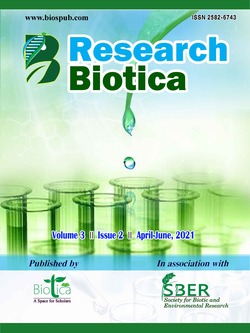
In vitro Evaluation of Leaf Extracts against Macrophomina phaseolina in Mulberry through Poisoned Food Technique
Deshmukh M.M.*
Dept. of Sericulture, Tamil Nadu Agriculture University, Coimbatore, Tamil Nadu (641 003), India
S. Vanitha
Dept. of Sericulture, Tamil Nadu Agriculture University, Coimbatore, Tamil Nadu (641 003), India
DOI: https://doi.org/10.54083/ResBio/3.2.2021.121-123
Keywords: Food Technique, In vitro, Macrophomina phaseolina, Mulberry, Mycelium, Sclerotia
Abstract
Mulberry (Morus alba L.) is a valuable tree of immense importance in silk industry due to its foliage, which constitute the chief food for silkworms (Bombyx mori L.) the source of fabulous silk. One of the major constraints in the cultivation and production of quality mulberry leaf is the attack of pests and diseases. Among the several diseases, root rot caused by Macrophomina phaseolina (Tassi) Goid is becoming a serious problem in many mulberry growing areas of south India. The root rot infected root samples were collected from the field and used for isolation of the pathogen. Cold water extracts of 10 plants species were screened against the mulberry root rot pathogen M. phaseolina. Among them, two plants extracts viz., curry leaf (Murraya koenigii L.) and Marunthukoorkan (Coleus forskohlii) showed the 67.77 percent and 61.10 percent inhibition of mycelial growth over control respectively. Similarly the sclerotial production showed 87.33 percent and 82.15 percent inhibition over control respectively.
Downloads
not found
Reference
Bhatnagar, K., Bansal, R.K., 2003. Trichoderma polysporum a new antagonist against Macrophomina phaseolina causing dry root-rot in cowpea. Journal of Mycology and Plant Pathology 33(2), 331.
Datar, V.V., 1999. Bioefficacy of plant extracts against Macrophomina phaseolina (Tassi) Goid the incitant of charcoal rot of sorghum. Journal of Mycology and Plant Pathology 29(2), 251-253.
Girijashankar, V., Thayumanavan, B., 2005. Investigations on in vitro fungi toxicity of Prosopis juliflora leaf extracts against selected soil-borne pathogens. Crop Research 29(3), 509-516.
Ravindran, S.A., Rao, A., Naik, V.G., Tikadar, A., Mukerje P., Thangavelu, K., 1997. Distribution and variation in mulberry germplasm. Indian Journal of Plant Genetic Resources 10(2), 233-242.
Sharma, M., Gupta, S.K., 2003. Eco-friendly methods for the management of root-rot and web blight (Rhizoctonia solani) of Frenchbean. Journal of Mycology and Plant Pathology 33(3), 345-361.
Shekhawat, P.S., Prasad, R., 1971. Antifungal properties of some plant extracts: Inhibition of spore germination. Indian Phytopathology 24, 800-802.
Vincent, J.M., 1927. Distortion of fungal hyphae in the presence of certain inhibitors. Nature 159, 850.
